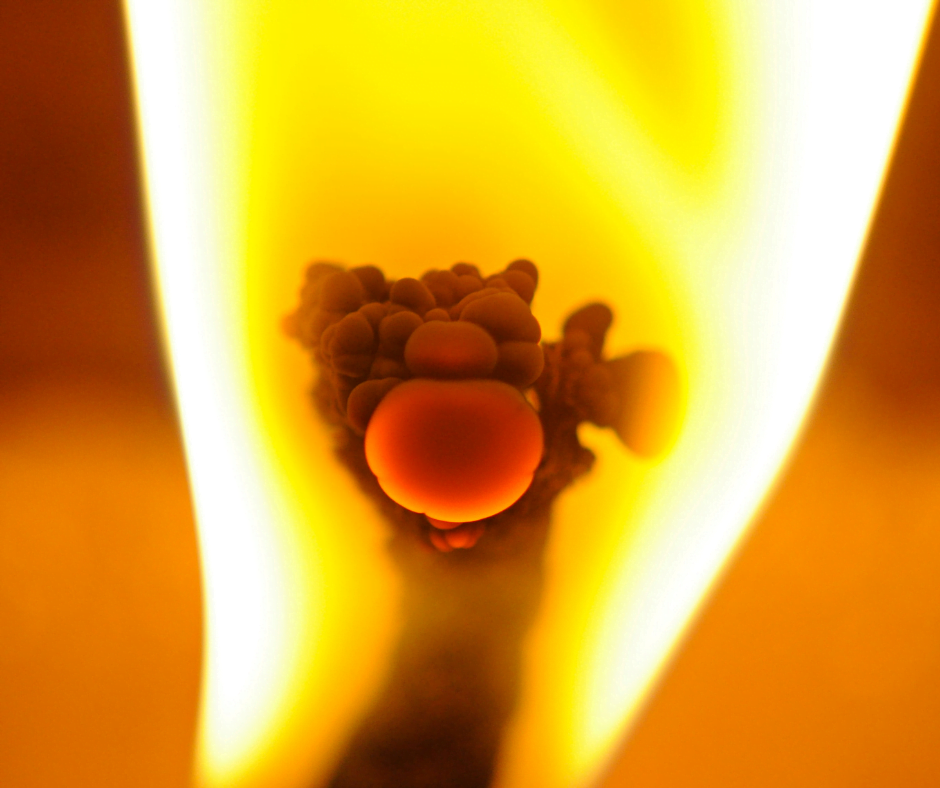If you’ve ever used a candle, you may have noticed that the wick sometimes starts to mushrooming. This is a common problem and can easily be fixed. This blog post will discuss what causes mushrooming wicks and how you can fix them. We will also provide tips on preventing this from happening in the future!
First, use the scissors to trim the mushrooming part of the wick down to about ¼ inch. Then, use the lighter to heat the tip of the wick for a few seconds. This will help to melt any remaining carbon. Blow out the candle, allow it to cool completely, and straighten the wick before relighting it.
We will now go on to review what causes mushrooming wicks and will show you how you can stop this from happening in the first place. We will also review and answer your frequently asked questions about mushrooming wicks.

What is a mushrooming wick?
As we all know, candles are made of wax. The wick allows the flame’s heat to melt the wax, vaporising and creating that lovely candlelight.
We’ve all seen what happens when a wick gets too long – it starts to “mushrooming.” Mushrooming is when the wick begins to curl over at the end and create a small ball of soot. Not only is this unsightly, but it can also be a fire hazard.
What does a mushrooming wick look like?
A mushrooming wick will look like it’s starting to curl over at the end and will form a small black ball. This black ball is made of soot and can be a fire hazard if left unchecked. If you look at the image below, you can see a picture of an example of a mushrooming wick.

Is it normal for wicks to mushroom?
Wick mushrooming is a common issue that will often happen to anyone that owns a candle. When a wick mushroom, it is an immediate sign that the wick is too long. This can happen due to the wick not being correctly trimmed or the wax burning quickly, exposing more of the wick from the wax.
What causes mushrooming wicks?
Mushrooming wicks are caused by a build-up of carbon on the wick. This can happen for several reasons, but the most common cause is improper wick trimming. When you light a candle, the heat from the flame melts the wax near the wick. This liquid wax is then drawn up the wick by capillary action. As the wax is drawn up, it cools and starts to solidify. This process repeats itself repeatedly, and a small amount of carbon is left on the wick with each cycle.
If the wick is not trimmed correctly, this carbon build-up will eventually cause the wick to mushroom. Mushrooming wicks can also be caused by using a candle in a drafty area or a low-quality candle.
If you happen to be someone that wants to avoid mushrooming wicks on candles outside, hold up for just a minute. We wrote an article all about how to keep you candles burning bright outside that we encourage you to read!
What other causes of a mushrooming wick are there?
There are several other causes of mushrooming wicks, but they are less common. The items listed below can have an impact on increasing the chance of a mushrooming with these include:
- Wick Size – Using a wick that is too thick for the candle can cause mushrooming. This is because there isn’t enough heat from the flame to vaporise all of the wax near the wick.
- Type of Wax – Using a harder wax can cause mushrooming. This is because it takes longer for the heat from the flame to melt the wax. If the incorrect wick is used for the wax type, this can be an impacting factor.
- Wick Type – Using zinc core wicks and coreless wicks can provide a more controlled burn. This is because they are designed to reduce mushrooming by maintaining a suitable length.
- Burn Time – If a candle is burned for too long, it can cause mushrooming. This is because the heat from the flame will start to break down the wick, causing it to fray.
How to solve mushrooming wicks and excess carbon on your candle?
The good news is that mushrooming wicks are easy to fix! All you need is a pair of scissors and a lighter. First, use the scissors to trim the mushrooming part of the wick down to about ¼ inch. Then, use the lighter to heat the tip of the wick for a few seconds. This will help to melt any remaining carbon on the wick. Finally, blow out the candle and allow it to cool completely before relighting it.

Does wick length matter?
The length of your wick can impact the performance of your candle. If the wick is too long, it will cause the candle to burn too quickly. If the wick is too short, it will cause the candle to burn slowly and unevenly. A mushrooming wick is an indication that the wick is too long and needs to be trimmed. A ¼ inch wick is the advised length and, in general, will avoid any issues caused by wick length.
Is a mushrooming wick bad?
Mushrooming wicks are not inherently bad, but they can be a fire hazard if left unchecked. The mushrooming wick will cause the flame to become larger, eventually leading to the candle burning out of control. Trimming the mushrooming wick to be the same length as the rest of the wick is essential. This will help to prevent the mushrooming wick from becoming a fire hazard.
If you happen to be someone that is also fed up of the common issue of smoke being released into your room once you blow out your candle, we have something just for you. We wrote an article all about how to stop your candle releasing smoke once blown out – take a look!
Final Thoughts
Now that you know how to fix mushrooming wicks let’s talk about how you can prevent them from happening in the first place. The best way to avoid mushrooming wicks is to trim the wick before each use. You should also avoid using candles in drafty areas and choose high-quality candles. By following these simple tips, you can enjoy your candles without worry! Thanks for reading, and happy candle-ing!
Do you have any tips for fixing mushrooming wicks? Please share them with us in the comments below!
Did you find this blog post helpful? Could you share it with your friends and family?
Do you have any questions about mushrooming wicks? Ask us in the comments below, and we’ll do our best to answer them!


